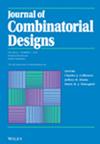Doubly sequenceable groups
IF 0.5
4区 数学
Q3 MATHEMATICS
引用次数: 0
Abstract
Given a sequence in a finite group with , let be the sequence of consecutive quotients of defined by and for . We say that is doubly sequenceable if there exists a sequence in such that every element of appears exactly twice in each of and . We show that if a group is abelian, odd, sequenceable, R-sequenceable, or terraceable, then it is doubly sequenceable. We also show that if is an odd or sequenceable group and is an abelian group, then is doubly sequenceable.
双序列群
给定有限群 G$G$ 中的序列 g:g0,...,gm${bf{g}}:{g}_{0},{\rm{\ldots }},{g}_{m}$,其中 g0=1G${g}_{0}={1}_{G}$, 让 g¯:g¯0,...,g¯m$\bar{\bf{g}}}:{\bar{g}}_{0},{\rm{\ldots }}、{\bar{g}}_{m}$ 是 g${bf{g}}$ 的连续商序列,定义为 g¯0=1G${\bar{g}}_{0}={1}_{G}$ 和 g¯i=gi-1-1gi${\bar{g}}_{i}={g}_{i-1}^{-1}{g}_{i}$ for 1≤i≤m$1\le i\le m$.如果在 G$G$ 中存在一个序列 g${/bf{g}}$,使得 G$G$ 的每个元素在 g${/bf{g}}$ 和 g¯$\bar{/bf{g}}$ 中都恰好出现两次,那么我们就说 G$G$ 是双重可序列的。我们证明,如果一个群是无性的、奇数的、可序列的、R-可序列的或梯级可序列的,那么它就是双重可序列的。我们还证明,如果 H$H$ 是奇群或可排序群,而 K$K$ 是无边群,那么 H×K$H\times K$ 是双重可排序的。
本文章由计算机程序翻译,如有差异,请以英文原文为准。
求助全文
约1分钟内获得全文
求助全文
来源期刊
CiteScore
1.60
自引率
14.30%
发文量
55
审稿时长
>12 weeks
期刊介绍:
The Journal of Combinatorial Designs is an international journal devoted to the timely publication of the most influential papers in the area of combinatorial design theory. All topics in design theory, and in which design theory has important applications, are covered, including:
block designs, t-designs, pairwise balanced designs and group divisible designs
Latin squares, quasigroups, and related algebras
computational methods in design theory
construction methods
applications in computer science, experimental design theory, and coding theory
graph decompositions, factorizations, and design-theoretic techniques in graph theory and extremal combinatorics
finite geometry and its relation with design theory.
algebraic aspects of design theory.
Researchers and scientists can depend on the Journal of Combinatorial Designs for the most recent developments in this rapidly growing field, and to provide a forum for both theoretical research and applications. All papers appearing in the Journal of Combinatorial Designs are carefully peer refereed.

 求助内容:
求助内容: 应助结果提醒方式:
应助结果提醒方式:


